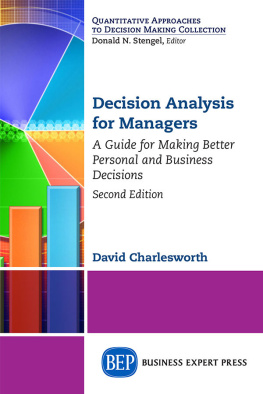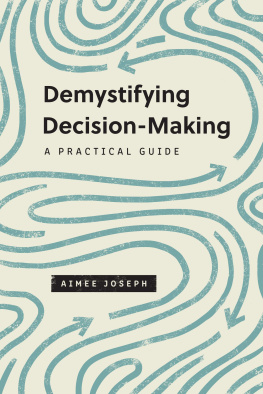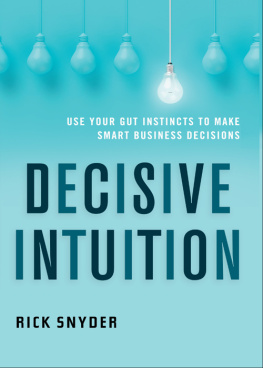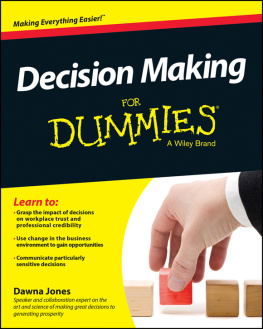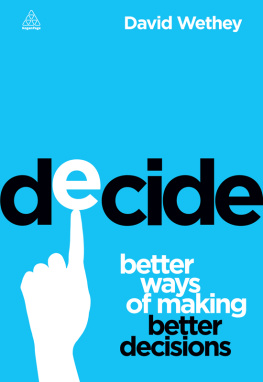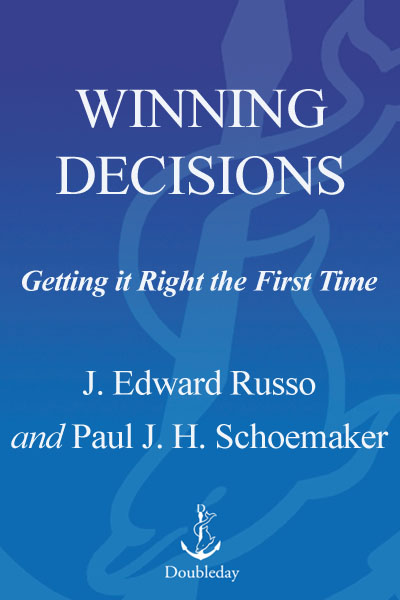
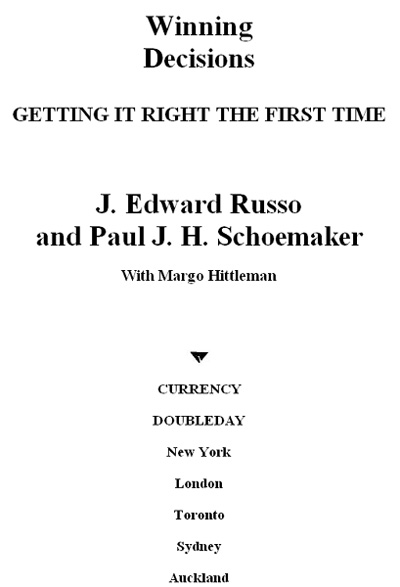
Contents
To Daniel Kahneman for his lifelong exploration of the mind of the decision-maker, continually taking us in new directions and revealing hidden patterns of preference, belief, and value;
To his equally remarkable collaborator, the late Amos Tversky, for his pioneering insights and rigorous formulations of the most fundamental problems and principles of the field; and
To the late Herbert A. Simon, a founder and intellectual leader of cognitive science over the last half century, for the model of his life.
Acknowledgments
Our book draws on multiple intellectual disciplinesfrom behavioral decision theory and decision analysis through artificial intelligence and problem-solving to group dynamics and creativity. In each discipline are dedicated researchers whose collective efforts have formed the intellectual basis for all that you will read below. We acknowledged some of these scholars by name in our early book Decision Traps (Doubleday, 1989) and our gratitude to them continues in this work.
In addition, we have benefited from the stimulating intellectual climates where we worked as academics, especially the University of Chicago (where we first met in the early 1980s), Cornell University, and the Wharton School of the University of Pennsylvania. Our colleagues there have provided much-appreciated support and challenge to our thinking over the years. Paul especially acknowledges John C. Hershey for our continuing dialogue in the context of our joint executive education at Wharton, as well as Howard C. Kunreuther and Paul Kleindorfer for numerous stimulating discussions while writing our joint book Decision Sciences: An Integrative Perspective (Cambridge Press, 1993). Thanks go as well to George Day, Roch Parayre, Howard Perlmutter, and Harbir Singh for our wide-ranging discussions about decision-making in organizations.
We are also grateful to the thousands of managers who have heard us speak about decision-making over the years. Their valuable feedbackwhether as questions, survey responses, or follow-up conversations and consultingcompelled us to respect more fully the complex challenge of real-world, real-time decisions. These numerous seminars and workshops were conducted at various universities, in public forums, and at the invitation of companies. There are too many for all to be listed, but we acknowledge in particular the following organizations:
University of California at Berkeley, University of Chicago, Cornell University, CEDEP at INSEAD, Duke University, University of North Carolina, MIT, and the Wharton School for their support of our executive education workshops; and
Abbott Laboratories, Arthur Andersen, Cargill, Coopers & Lybrand, CUES, Eli Lilly, General Motors, Harris Bank, IBM, Johnson & Johnson, Knight-Ridder, Lever Brothers, Lucent, National WestMinister Bank, New York Life, Royal Dutch/Shell, State Farm, and the U.S. Forest Service for their repeated in-house offerings of our executive decision programs.
Several individuals played essential roles in the making of this book.
John Oakes teamed up with us in the mid-1990s to design a management training program based on our book Decision Traps. We have benefited not only from his great interest in this subject and his vast experience in training and human resource management, but as much from his patient insistence on practical and user-friendly expositions of our more obtuse concepts and techniques. He helped sharpen our exercises while adding many tools and tips where they were needed. Our intellectual journey with him changed our own thinking, as reflected in the present writing, and we acknowledge his substantial contribution with gratitude.
Richard Roll, CEO of RealHome.com, Inc., volunteered his time and risked the exposure of his decision processes to all who read chapter 10. It is one thing to make a decision; it is another to observe and describe it; and it is still more to reveal it with candor to two critical scholars for commented publication. For all of the above, Richard has our gratitude and respect.
In addition, we are indebted to our writer, Margo Hittleman, who undertook the challenging task of getting two strong-minded decision researchersliving in two different citiesto see eye to eye on numerous theoretical issues and applied questions. Her patience, discipline, insight, and professionalism brought much-needed structure and coherence to our original thinking. Whatever merit the writing style itself possesses goes to Margo. She performed admirably under deadline, and without her this book would not have been published in its present form and at this time.
We thank Barb Drake for her remarkable clerical and administrative support as well as Angela Horne for her contribution as a reference librarian. In addition, we thank Roger Scholl and Stephanie Land at Doubleday for their editing.
INTRODUCTION
Decision-Making in
the Real World
In the affair of so much importance to you, wherein you ask my advice, I cannot for want of sufficient premises advise you what to determine, but if you please I will tell you how. Benjamin Franklin
The American botanist and explorer David Fairchild recounts the following tale. I had been dining with our old friends, the Arthur Bullards, and late in the evening Herbert Hoover came in. He dropped wearily into an easy chair, as if he had just come from his office. Mr. Bullard said something to him about my going on a long plant hunting expedition. He looked up in a tired way and asked, Does he have to make decisions on such a trip? If not, Id like to go along. Im tired of making decisionsone after another all day long. My view of Heaven is of a place where no one ever has to make a decision.
If you are like many professionals we know, you can echo President Hoovers sentiments. But you are unlikely to find his Heaven manifest on earth. If anything, more people are making more decisionsand are being forced to make them fasterin an increasingly unpredictable and less forgiving environment, where more is at stake than ever before.
Whether you work in business, government, professional services, education, or the not-for-profit sector, the same scenario probably reigns. High speed rules decision-making as well as everything else. In a world that moves at Web speed, time cannot be sacrificed for better quality, lower cost, or even better decisions, recently observed John Roth, president and CEO of Canadas Nortel Networks.
Whatever their role and organization, most professionals have to make a decision nowfollowed by another decision now, followed by yet another. If that werent challenging enough, more is at stake than ever before. The terrain for todays decision-maker is a minefield in which any misstep can provoke a devastating explosion. In this sped-up world, you are likely to have exactly one shot to get a decision right, not three. And if you get it wrong, you have less time to correct mistakes and reestablish credibility. Its enough to make anyone tired. But those very challenges can provide unprecedented opportunity and strategic advantageif you can embrace the responsibility for making good, fast, frequent decisions, and if you can do so better than those against whom you compete.
Simple enough to say, we concede. But how can a decision-maker rapidly assess the situation, gather needed information, consider it thoroughly, and reach an intelligent conclusion? How can one make good, fast, frequent,
Next page

